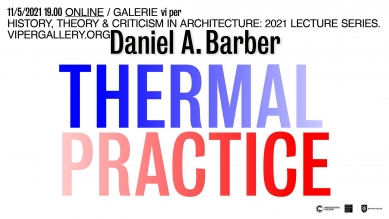
Daniel A. Barber: Thermal Practice - on-line přednáška galerie VI PER
Pořadatel
Galerie VI PER
Místo konání
Zoom meeting
Začátek
út 11.5.2021 19:00
Odkaz
www.facebook.com ...
Galerie VI PER
Místo konání
Zoom meeting
Začátek
út 11.5.2021 19:00
Odkaz
www.facebook.com ...
Přednášky
Praha
Vložil
Tisková zpráva
Tisková zpráva
Thermal Practice aims to reposition familiar narratives and protagonists of modern architectural history, now revolving around climate and carbon as organizing figures of thought. Case studies of the thermal interior – as an aggregate of distinct designed spaces and as the experiential condition of politics and inequity – will serve as evidence for a history of architecture as a device of climatic adaptability; other concepts for rethinking forms of practice, models, methods and habits will encourage some collective speculation on architecture after carbon – its contours and principles, its obstacles and opportunities.
The presentation will focus on decentering narratives of modern architectural development through a discussion of the brise soleil in Brazil – through buildings and projects that elaborated inter-war design principles to produce dynamic facade systems. On the one hand, these systems mitigated the effects of diurnal and seasonal solar patterns; on the other hand they aimed to produce normative spaces that drew the flow of capital further south. A subsequent globalization of the international style led to a proliferation of climate design strategies, too often used as methods of neo- or endo-colonialism. Such practices offer a complex counter-narrative as well as novel design strategies for the move away from fossil fuels in the present.
Daniel A. Barber is Associate Professor and Chair of the PhD Program in Architecture at the University of Pennsylvania. His most recent book is Modern Architecture and Climate: Design before Air Conditioning (Princeton UP, 2020); an article “Active Passive: Heat Storage and the Solar Imaginary” recently appeared in South Atlantic Quarterly. His research and teaching narrate eco-critical histories of architecture and seek pathways into the post-carbon future. He is a 2021–22 Fellow at the Käte Hamburger Centre for Apocalyptic and Post-Apocalyptic Studies at Universität Heidelberg. Daniel edits the Accumulation series on e-flux architecture and is co-founder of Current: Collective on Environment and Architectural History.
The presentation will focus on decentering narratives of modern architectural development through a discussion of the brise soleil in Brazil – through buildings and projects that elaborated inter-war design principles to produce dynamic facade systems. On the one hand, these systems mitigated the effects of diurnal and seasonal solar patterns; on the other hand they aimed to produce normative spaces that drew the flow of capital further south. A subsequent globalization of the international style led to a proliferation of climate design strategies, too often used as methods of neo- or endo-colonialism. Such practices offer a complex counter-narrative as well as novel design strategies for the move away from fossil fuels in the present.
Daniel A. Barber is Associate Professor and Chair of the PhD Program in Architecture at the University of Pennsylvania. His most recent book is Modern Architecture and Climate: Design before Air Conditioning (Princeton UP, 2020); an article “Active Passive: Heat Storage and the Solar Imaginary” recently appeared in South Atlantic Quarterly. His research and teaching narrate eco-critical histories of architecture and seek pathways into the post-carbon future. He is a 2021–22 Fellow at the Käte Hamburger Centre for Apocalyptic and Post-Apocalyptic Studies at Universität Heidelberg. Daniel edits the Accumulation series on e-flux architecture and is co-founder of Current: Collective on Environment and Architectural History.

0 komentářů
přidat komentář
Související články
0
09.09.2021 | Architecture Uncomfortable Workshop - představení knihy v galerii VI PER
0
22.08.2021 | Erika Henriksson: Making-with - přednáška v Galerii VI PER
0
13.07.2021 | Planning and Building Methods - výstava v galerii VI PER
0
19.01.2021 | Ala Younis: High Dam - on-line přednáška galerie VI PER
0
14.12.2020 | M.Agha & L.Allais: Nubia Still Exists - on-line přednáška galerie VI PER
1
08.12.2020 | Elise Misao Hunchuck: Air - on-line přednáška galerie VI PER











